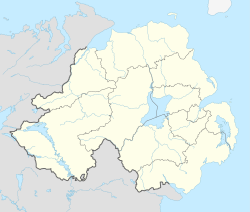| Moy | |
|---|---|
 | |
Location within Northern Ireland | |
| Population | 1,941 (2021 census) |
| Irish grid reference | H7962 |
| District | |
| County | |
| Country | Northern Ireland |
| Sovereign state | United Kingdom |
| Post town | DUNGANNON |
| Postcode district | BT71 |
| Dialling code | 028 |
| UK Parliament | |
| NI Assembly | |
| Website | moyni.weebly.com |
Moy (from Irish an Maigh, meaning 'the plain') [2] [3] is a village and townland in County Tyrone, Northern Ireland about 5 miles (8 kilometres) southeast of Dungannon and beside the smaller village of Charlemont. Charlemont is on the east bank of the River Blackwater and Moy on the west; the two are joined by Charlemont Bridge. The river is also the boundary between County Tyrone and County Armagh. The 2021 census recorded a population of 1,941. [4]
